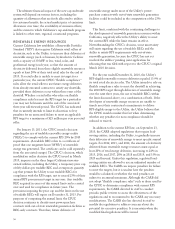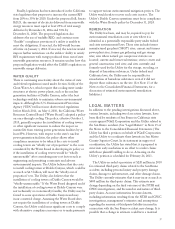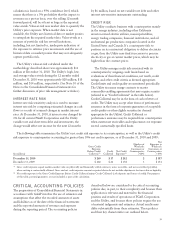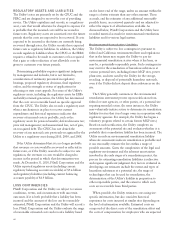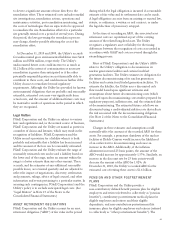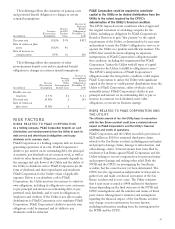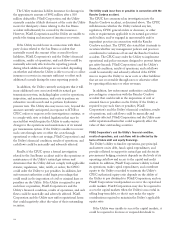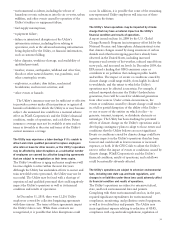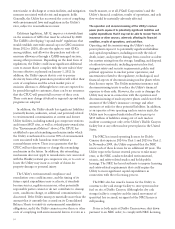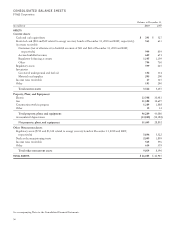PG&E 2010 Annual Report Download - page 50
Download and view the complete annual report
Please find page 50 of the 2010 PG&E annual report below. You can navigate through the pages in the report by either clicking on the pages listed below, or by using the keyword search tool below to find specific information within the annual report.If capital spending in a particular time period is greater
than assumed when rates were set, earnings could be
negatively affected by an increase in depreciation, taxes,
and financing interest and the absence of authorized
revenue requirements to recover an ROE on the amount of
capital expenses that exceeds assumed amounts.
PG&E Corporation’s and the Utility’s financial statements
reflect various estimates, assumptions, and values; changes to
these estimates, assumptions, and values – as well as the
applicationof and changes inaccountingrules, standards,
policies, guidance, orinterpretations – could materially affect
PG&E Corporation’s and the Utility’s financial conditionor
results of operations.
The preparation of financial statements in conformity with
GAAP requires management to make estimates and
assumptions that affect the reported amounts of revenues,
expenses, assets, and liabilities, and the disclosure of
contingencies. (See the discussion under Note 1 of the
Notes to the Consolidated Financial Statements and the
section entitled “Critical Accounting Policies” above.) If
the information on which the estimates and assumptions
are based proves to be incorrect or incomplete; if future
events do not occur as anticipated; or if there are changes
in applicable accounting guidance, policies, or
interpretation, management’s estimates and assumptions
will change as appropriate. A change in management’s
estimates or assumptions, or the recognition of actual
losses that differ from the amount of estimated losses,
could have a material impact on PG&E Corporation’s and
the Utility’s financial condition, results of operations, and
cash flows. For example, if management can no longer
assume that potentially responsible parties will pay a
material share of the costs of environmental remediation,
or if PG&E Corporation or the Utility incurs losses in
connection with environmental remediation; litigation; or
other legal, administrative, or regulatory proceedings that
materially exceed the provision it estimated for these
liabilities, or if such amounts are not recoverable in rates,
PG&E Corporation’s and the Utility’s financial condition,
results of operations, and cash flows would be materially
adversely affected.
PG&E Corporation’s and the Utility’s financial condition
depends uponthe Utility’s ability to recoverits costs ina
timely mannerfrom the Utility’s customersthrough regulated
rates and otherwise execute its business strategy.
The Utility’s financial condition particularly depends on its
ability to recover in rates, in a timely manner, the costs of
electricity and natural gas purchased for its customers, its
operating expenses, and an adequate return of and on the
capital invested in its utility assets, including the costs of
long-term debt and equity issued to finance their
acquisition. Unanticipated changes in operating expenses
or capital expenditures can cause material differences
between forecasted costs used to determine rates (for
example, in a general rate case) and actual costs incurred,
which, in turn, affect the Utility’s ability to earn its
authorized rate of return. In addition, the CPUC or the
FERC may not allow the Utility to recover costs that it has
already incurred on the basis that such costs were not
reasonably or prudently incurred, or for other reasons.
The Utility has entered into a settlement agreement that,
if adopted by the CPUC, will set the Utility’s revenue
requirements for its basic electric and natural gas
distribution operations and its electric generation
operations through 2013. (See “Regulatory Matters – 2011
General Rate Case Application” above.) It is uncertain
whether the settlement agreement will be approved.
The CPUC also has authorized the Utility to collect
rates to recover the costs of various public policy programs
that provide customer incentives and subsidies for energy
efficiency programs and for the development and use of
renewable and self-generation technologies. As customer
rates rise to reflect these programs, subsidies, customer
incentives, or shareholder incentives, the risk may increase
that the CPUC or another state authority will disallow
recovery of some of the Utility’s costs based on a
determination that the costs were not reasonably incurred
or for some other reason.
In addition, changes in laws and regulations or changes
in the political and regulatory environment may have an
adverse effect on the Utility’s ability to timely recover its
costs and earn its authorized rate of return. During the
2000 through 2001 energy crisis that followed the
implementation of California’s electric industry
restructuring, the Utility could not recover in rates the high
prices it had to pay for wholesale electricity, which
ultimately caused the Utility to file a petition for
reorganization under Chapter 11 of the U.S. Bankruptcy
Code. In 2003, PG&E Corporation, the Utility, and the
CPUC entered into a settlement agreement to resolve the
Utility’s Chapter 11 proceeding, which was incorporated
into the Utility’s plan of reorganization that became
effective in April 2004. Even though the settlement
agreement and current regulatory mechanisms contemplate
that the CPUC will give the Utility the opportunity to
recover its reasonable and prudent future costs of electricity
and natural gas in its rates, the CPUC may not find that all
of the Utility’s costs are reasonable and prudent, or the
CPUC may take actions or fail to take actions that would
be to the Utility’s detriment. In addition, the bankruptcy
court having jurisdiction of the Chapter 11 settlement
agreement or other courts may fail to implement or enforce
46


